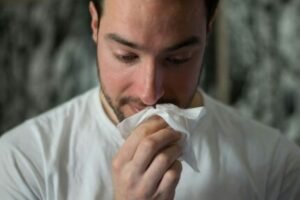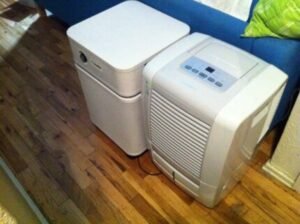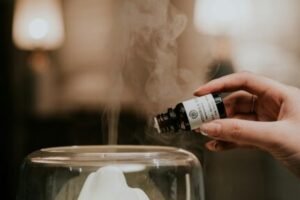Medically reviewed by Dr. Ramesh Gaddam, M.D. — Written by Sumalatha, D.N.H.E
Table of Contents
ToggleEosinophilic bronchitis is a condition that causes a persistent dry cough without the wheezing typical of asthma. Many people haven’t heard of it, but understanding this condition is important because it often goes undiagnosed.
Unlike asthma, eosinophilic bronchitis doesn’t cause airflow obstruction, making it tricky to identify.
However, with the right information and treatment, it can be effectively managed. This guide explains the causes, symptoms, and treatment options to help you better understand eosinophilic bronchitis.
1. What Causes Eosinophilic Bronchitis?
Eosinophilic bronchitis happens when certain white blood cells, called eosinophils, build up in the airways, causing inflammation. This inflammation triggers a persistent cough. The condition can be caused by:
- Allergens: Common triggers include pollen, dust mites, and mold.
- Irritants at Work: Chemicals or dust in the workplace can lead to symptoms.
- Other Environmental Factors: Air pollution or tobacco smoke can also play a role.
Understanding these triggers can help in managing the condition effectively.
2. Symptoms of Eosinophilic Bronchitis
Eosinophilic bronchitis mainly causes a chronic dry cough that lasts more than 6-8 weeks. Unlike asthma, this condition does not involve wheezing or breathing difficulties. Other key symptoms include:
- Thick, Sticky Mucus: Some people may notice viscid sputum when coughing.
- Symptoms of Rhinitis: You might experience sneezing, nasal congestion, or runny nose.
These symptoms can disrupt daily life, affecting sleep and overall comfort. If you notice a persistent cough without wheezing, consider seeking medical advice.
3. How Is Eosinophilic Bronchitis Diagnosed?
Diagnosing eosinophilic bronchitis starts with reviewing your medical history and discussing your cough.
The doctor will also listen to your lungs to check for other issues.
Tests may include analyzing mucus to find eosinophils, checking lung function with a spirometer, and a test to see if your airways react to certain substances.
These steps help pinpoint eosinophilic bronchitis and rule out other causes of a persistent cough.
4. Treatment Options for Eosinophilic Bronchitis
Eosinophilic bronchitis is typically treated with inhaled corticosteroids, such as budesonide, to reduce airway inflammation.
These medications are effective in controlling the chronic cough. If symptoms persist, oral corticosteroids may be prescribed for a short period.
Antihistamines can also help if allergies are a trigger.
Beyond medication, lifestyle changes like avoiding known allergens and improving indoor air quality are important.
With the right treatment and care, most people can manage their symptoms effectively.
5. Preventing Eosinophilic Bronchitis
Preventing eosinophilic bronchitis largely involves avoiding known triggers. Start by identifying allergens through allergy testing, and take steps to minimize exposure.
Using air purifiers, keeping your home dust-free, and avoiding smoke or strong fumes can help reduce the risk.
Regularly monitoring your environment and staying aware of your symptoms are key.
Educating yourself about the condition and maintaining open communication with your healthcare provider will also aid in prevention and early management.
6. Clearing Up Myths About Eosinophilic Bronchitis
There are a few common misconceptions about eosinophilic bronchitis.
Some believe it’s the same as asthma, but that’s not true—while both involve airway inflammation, eosinophilic bronchitis doesn’t cause wheezing or airflow obstruction.
Another myth is that it only affects people who smoke or have asthma, but anyone can develop it.
The fact is, eosinophilic bronchitis can occur without asthma, and effective treatments are available to manage the condition.
7. Home Remedies for Eosinophilia Cough
Managing an eosinophilia-related cough at home involves natural approaches that can help ease symptoms and support overall health. Here are some effective remedies:
Steam Inhalation
Breathing in steam can soothe irritated airways and reduce coughing. Add a few drops of eucalyptus or peppermint oil to the water for extra relief.
Honey and Warm Water
Honey is a natural cough suppressant. Mixing a teaspoon of honey in warm water or tea can calm your throat and reduce coughing.
Ginger Tea
Ginger has anti-inflammatory properties that can help reduce airway irritation. Drink ginger tea or chew on fresh ginger slices to relieve your cough.
Stay Hydrated
Drinking plenty of water keeps mucus thin and helps clear your airways. Warm fluids like herbal teas or broth are especially soothing.
Salt Water Gargle
Gargling with warm salt water can reduce throat irritation and inflammation, helping to ease coughing.
Turmeric Milk
Turmeric has anti-inflammatory and antioxidant properties. Mixing turmeric powder with warm milk can help soothe the throat and reduce coughing.
Avoid Triggers
Identify and avoid allergens or irritants, like dust, pollen, or smoke, that might worsen your cough.
These home remedies can provide comfort and support for managing an eosinophilia cough. However, it’s important to consult with a healthcare provider for proper diagnosis and treatment.
Conclusion
In summary, understanding eosinophilic bronchitis is important for managing its symptoms effectively.
This condition, marked by a persistent dry cough, requires proper diagnosis and treatment.
By learning about its causes, recognizing the symptoms, and following treatment and prevention strategies, you can better manage your health.
Staying informed and working closely with your doctor can lead to improved outcomes and a better quality of life.
Frequently Asked Questions (FAQs)
What Medication Is Used for Eosinophilic Bronchitis?
Inhaled corticosteroids, such as budesonide or fluticasone, are commonly used to treat eosinophilic bronchitis by reducing airway inflammation.
In some cases, oral corticosteroids may be prescribed if symptoms persist.
How to Test for Eosinophilic Bronchitis?
To test for eosinophilic bronchitis, doctors may perform sputum analysis to check for high levels of eosinophils.
Spirometry is also used to assess lung function and rule out asthma. A methacholine challenge test may be conducted to exclude airway hyperresponsiveness.
How Do You Treat Eosinophilia Symptoms?
Eosinophilia symptoms are typically treated with corticosteroids to reduce inflammation.
Managing underlying causes, such as allergies or infections, is also important. Antihistamines or leukotriene inhibitors may be prescribed to address associated allergic reactions.
What Is the Best Medicine for Eosinophilia?
Corticosteroids, like prednisone, are the most effective medications for treating eosinophilia.
They work by reducing eosinophil levels in the blood and alleviating related symptoms.
What Is the Best Food to Reduce Eosinophils?
Foods rich in anti-inflammatory properties, such as omega-3 fatty acids (found in fish and flaxseeds), green leafy vegetables, and fruits like berries, may help reduce eosinophils.
Probiotics found in yogurt can also support a balanced immune response.
What Is the Best Home Remedy for Eosinophilia?
Turmeric, ginger, and honey are effective home remedies for managing eosinophilia.
Turmeric’s anti-inflammatory properties, combined with ginger’s soothing effects and honey’s natural healing abilities, can help reduce symptoms naturally.
What Not to Eat in Eosinophilia?
Avoid foods that trigger allergies or inflammation, such as dairy, processed foods, and foods high in sugar or trans fats.
Identifying and eliminating specific food allergens can also help in managing eosinophilia symptoms effectively.
What Is Eosinophilic Bronchitis?
Eosinophilic bronchitis is a condition characterized by a persistent dry cough caused by inflammation in the airways. This inflammation is due to an increase in eosinophils, a type of white blood cell, in the airways.
What Causes Eosinophilic Bronchitis?
The condition is often triggered by allergens like pollen, dust mites, or workplace irritants. Other environmental factors, such as air pollution or tobacco smoke, can also contribute.
How Is Eosinophilic Bronchitis Different from Asthma?
Unlike asthma, eosinophilic bronchitis does not cause wheezing or airflow obstruction. However, both conditions involve inflammation of the airways.
What Are the Main Symptoms of Eosinophilic Bronchitis?
The primary symptom is a chronic dry cough lasting more than 6-8 weeks. Some people may also produce thick, sticky mucus, but there is no wheezing.
How Is Eosinophilic Bronchitis Diagnosed?
Diagnosis involves a medical history review, lung function tests, and sputum analysis to detect eosinophils. Tests like spirometry and a methacholine challenge may also be used to rule out asthma.
What Treatments Are Available for Eosinophilic Bronchitis?
Inhaled corticosteroids are the first line of treatment to reduce airway inflammation. In some cases, oral corticosteroids or antihistamines may be prescribed. Avoiding known triggers is also important.
Can Eosinophilic Bronchitis Be Cured?
While there is no permanent cure, eosinophilic bronchitis can be effectively managed with treatment and lifestyle adjustments, allowing most people to lead normal lives.
What Lifestyle Changes Can Help Manage Eosinophilic Bronchitis?
Avoiding allergens, using air purifiers, and keeping your home dust-free can help. Staying hydrated and practicing good indoor air quality are also beneficial.
Is Eosinophilic Bronchitis a Common Condition?
Eosinophilic bronchitis is less common than asthma but is increasingly recognized, especially in people with a chronic cough that isn’t related to asthma or other respiratory conditions.
When Should I See a Doctor for Eosinophilic Bronchitis?
If you have a persistent dry cough lasting more than 6-8 weeks, or if you notice thick mucus production, it’s important to see a doctor for proper diagnosis and treatment.
What Is the Difference Between Asthma and Eosinophilic Bronchitis?
Asthma and eosinophilic bronchitis both involve airway inflammation, but asthma also causes wheezing and airflow obstruction due to constricted airways.
Eosinophilic bronchitis, on the other hand, primarily leads to a persistent dry cough without the wheezing or airflow limitation typical of asthma.
How Do You Treat an Eosinophilic Cough?
An eosinophilic cough is usually treated with inhaled corticosteroids to reduce airway inflammation.
If the cough persists, oral corticosteroids or antihistamines may be prescribed. Avoiding known triggers, such as allergens or irritants, is also crucial in managing the condition.
Can You Live a Normal Life with Eosinophilic Asthma?
Yes, with proper management and treatment, individuals with eosinophilic asthma can lead a normal life.
Regular use of prescribed medications, avoiding triggers, and having a solid action plan with your doctor can help control symptoms effectively.
What Is the Best Medicine for Bronchitis?
The best medicine for bronchitis depends on its cause.
For acute bronchitis, which is usually viral, rest, fluids, and over-the-counter pain relievers are recommended.
In chronic bronchitis, inhaled corticosteroids and bronchodilators are often used to manage symptoms. Antibiotics may be prescribed if a bacterial infection is present.
What Is the Fastest Way to Recover from Bronchitis?
The fastest way to recover from bronchitis includes getting plenty of rest, staying hydrated, using a humidifier to ease breathing, and avoiding irritants like smoke.
Over-the-counter medications can help relieve symptoms, but it’s essential to follow your doctor’s advice.
Is There a Permanent Cure for Bronchitis?
There is no permanent cure for chronic bronchitis, which is a form of COPD, but symptoms can be managed with treatment.
Acute bronchitis usually resolves on its own with proper care. Managing symptoms and avoiding triggers are key to long-term health.
What Not to Eat with Bronchitis?
Avoid foods that can worsen inflammation or mucus production, such as dairy products, processed foods, sugary snacks, and fried foods.
Spicy foods may also irritate the throat and worsen coughing.
What Is the Best Drink for Bronchitis?
Warm fluids, such as herbal teas, broth, and warm water with honey and lemon, are the best drinks for bronchitis.
These help soothe the throat, thin mucus, and keep you hydrated.
How Do You Clear Your Lungs from Bronchitis?
To clear your lungs from bronchitis, stay hydrated to thin mucus, use a humidifier, practice deep breathing exercises, and consider chest physiotherapy if recommended by your doctor.
Avoiding irritants like smoke is also crucial for lung health.
References:
[1] https://www.ncbi.nlm.nih.gov/pmc/articles/PMC1746245/pdf/v057p00178.pdf
[2] https://www.ncbi.nlm.nih.gov/pmc/articles/PMC4531654/
[3] https://www.atsjournals.org/doi/10.1164/ajrccm.160.2.9810100
[4] https://karger.com/iaa/article/147/1/1/165431/Eosinophilic-Bronchitis-without-Asthma
[5] https://thorax.bmj.com/content/57/2/178.abstract
[6] https://onlinelibrary.wiley.com/doi/10.1046/j.1365-2222.2000.00740.x
[7] https://www.thelancet.com/journals/lancet/article/PIIS0140-6736%2801%2906224-9/fulltext
[8] https://www.verywellhealth.com/eosinophilic-bronchitis-5185499
Also Read:
Medically reviewed by Dr. Ramesh Gaddam, M.D.

General Physician, Diabetologist, and Critical Care Specialist.




